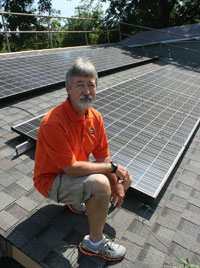Dr. Doug Weirick lives what he teaches.
The professor and chair of East Central University’s Environmental Health Science Department is concerned about global climate change. So concerned that he practices concepts he teaches about at ECU to help reduce climate change while at home and also at work on the university campus.
At home, he has scaled down the use of fossil fuels by installing a photovoltaic (PV) system and a solar hot water heating system. The PV system includes PV modules which most people refer to as solar panels mounted on the roof. Weirick also drives a neighborhood electric vehicle called Zenn (Zero Emission No Noise) when commuting to campus and running errands in Ada.
On campus, Weirick teaches his students about PV modules and other components of renewable energy systems using a fully-functional, grid-tied PV system as a teaching tool. The system is located on a simulated roof deck near the Physical and Environmental Sciences Building on the north side of campus.
Money to purchase the PV systems at ECU was obtained as part of a Veterans Workforce Grant funded by the Oklahoma Department of Commerce. Materials used to construct the simulated roof deck were donated by the Mead Lumber Company in Ada. Labor to construct the roof deck was donated by the ECU administration and the actual construction was performed by the ECU Physical Plant staff.
“The system includes 14 PV modules, each rated at 210 watts, connected together in series which provides a total of about 3000 watts. Each PV module works like a battery with positive and negative connections,” Weirick said. “Underneath the PV modules and simulated roof deck is a breaker box and device known as inverter which changes direct current (or DC) power into alternating current (or AC) power. Also included in the system is a bidirectional electric meter capable of measuring the number of kilowatt hours of electricity produced and the number consumed.”
Weirick added that when more electricity is being produced by the PV system than is being consumed, power is sent to the utility grid. Since some Oklahoma utilities have net metering programs, electricity sent to the grid from a private source can provide credits to offset a customer’s utility bill.
According to Weirick, current PV modules have the ability to convert approximately 15 percent of light energy which strikes them into electricity. PV module technology has continued to improve in recent years and several research groups have constructed small PV modules which have efficiencies of greater than 30 percent.
At the same time, the price of PV modules have decreased dramatically, enabling homeowners to save money on their utility bills by installing PV systems on their roofs and in their yards. The length of time required for homeowners to recover the costs of purchasing and installing a properly-sized PV system is about 10-15 years and it is common for PV modules to be warranted for 20-25 years.
Although the PV system at ECU has the potential to help the university save a little money on its electricity bill, this wasn’t his original motivation for installing the system. The system was intended to help teach veterans and other interested people about the basics of PV system operation and the opportunity for jobs in the PV industry by selling and installing them.
“I’m hoping to continue to use this system to teach about PV systems and renewable energy even though the grant project is over,” Weirick said. “My goal is to teach students and other people in the community about PV systems and renewable energy as important ways to help mitigate global climate change.”
He has already taught a couple of hundred people the basics of the system and is looking to instruct even more in the near future.
-ECU-

